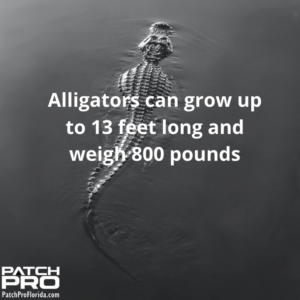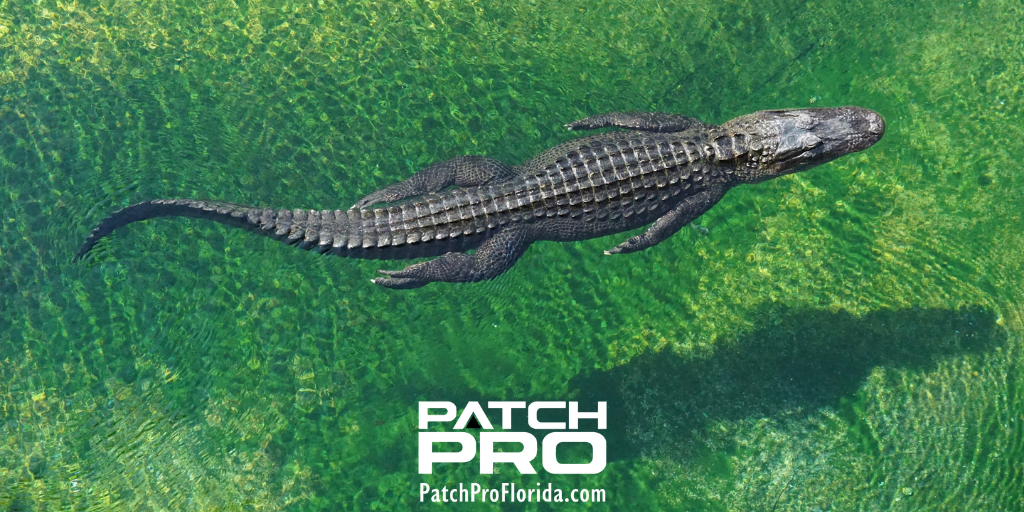If you grew up outside of Florida, you probably enjoyed a picnic beside a pond or a walk alongside a river. In Florida, there is a big reason you can’t do that…ALLIGATORS! Here, you have to keep your head on a swivel when near any body of water, just in case one of the millions of alligators that live in the Sunshine State decide to grace you with their presence.
And, if you’re from out of Florida and stumbled upon our blog in search of places to spot alligators, we’ve got suggestions for you. But, please, keep your kids out of the local ponds while visiting here. While uncommon, every couple of years there is a story of a kid wandering into a pond and meeting their fate at the teeth of a hungry gator.
While exploring the official home of the reptile, you can usually spot the alligator interrupting par on golf courses, sunning themselves in lakes, and dominating the Everglades. The gator is even featured as the mascot to one of the country’s biggest universities, our University of Florida Gators.
Whether you want to witness the prehistoric beast in the wild or behind a barrier in the safety of a zoo, there are plenty of places to look at this Triassic dinosaur.
History of Gators in Florida
Gators have roamed the habitat of the Sunshine State for many centuries and can be found in 67 counties. Because of an increased human population, alligators were considered an endangered species in 1973. Due to increased conservative efforts, the species is now plentiful throughout the state.
If there’s a body of water — whether natural or man-made — chances are you’ll find an alligator in it.
Facts About Alligators
 The word “alligator” derives from the Spanish word for lizard (el largarto) — the term early settlers of Florida used when first coming across the predatory reptiles. Alligators prefer freshwater habitats, warm climates, and live alongside saltwater crocodiles in the state — the only place in the world where both coexist. There are an estimated five million alligators in the United States, with a quarter located in Florida; the largest population of alligators thrives in Gainesville.
The word “alligator” derives from the Spanish word for lizard (el largarto) — the term early settlers of Florida used when first coming across the predatory reptiles. Alligators prefer freshwater habitats, warm climates, and live alongside saltwater crocodiles in the state — the only place in the world where both coexist. There are an estimated five million alligators in the United States, with a quarter located in Florida; the largest population of alligators thrives in Gainesville.
Males can grow up to 13 feet long and weigh 800 pounds, with the largest ever recorded measuring 17.5 feet. The species is a living garbage disposal, consuming nearly everything. If prey is too large to gobble in a single bite, the alligator will violently spin in a “death roll” to drown it.
The largest reptile in North America is also the official state reptile of our state of Florida.
Top Gator Viewing Locations
If you’re looking to take a road trip and embark on an exciting activity, go check out some gators. Wherever you live in Florida, a prime spot to check out alligators is within a short drive. Here are some of the best places in Florida to see Alligators:
Everglades
This one is a no-brainer. Just make sure you bring your bug spray. A lot of bug spray!
The largest subtropical wilderness in the United States spans across 1.5 million acres of wetland preserve and houses the world’s most diverse ecosystem. Established as a National Park in 1934, this international treasure is a protected area under the Cartagena Treaty and is considered an International Biosphere Reserve. Immersed amongst the mangroves and floating through the swamplands are 200,000 gators.
The alligator is considered a vital part of the freshwater marshes; burrowed dens in the winter allows refuge for other animals during dry seasons. Also, the nesting activities of female gators are important for the creation of peat.
Gatorland
Located in Orlando, this 110-acre theme park houses 2,000 gators and is known as “The Gator Capital Of The World”. Founded in 1949, the amusement park is completely themed around the grinning cold-blooded killers: Gatorland boasts a “Screamin’ Gator Zipline”, “Stompin Gator Off-Road Adventure”, and “Gator Jumparoo”. Sizes of the reptiles range from grunts to 14-foot monsters, all seen at the “Breeding Marsh” home.
Gatorland also houses the largest collection of albino and white leucistic alligators.
Popular in the park is the “Adventure Hour”, a behind-the-scenes reservation-only experience where visitors are permitted beyond the protective fence to encounter thousands of sharp-toothed residents up-close.
Lake George
Florida eclipses Minnesota’s claim as the “land of lakes” with 30,000 watering holes. You can bet some of them are rife with gators.
Located off St. Johns River in Northwest Florida, Lake George has the most gators overall amongst any lake in the United States.
The lake is approximately six miles across, 11 miles around, and is recognized as one of Florida’s largest lakes. A sustainable habitat for a sizable population of alligators, the plentiful marine life supplies steady feed for the reptiles.
Smugglers Cove Adventure Golf
What’s mini-golf without a wildlife experience? This Florida chain (with two locations in the Tampa area) has some creative greens with low pars to entice amateur golfers, as well as actual live alligators.
The 18-hole course takes competitors through pirate ships, caves, waterfalls, and a gator habitat. Each Smugglers golf course houses an “Educational American Alligator Exhibit” that is home to 30 alligators that visitors can actually feed by using cane fishing poles. The snapping and clamping jaws close on dried meat, giving observers an up-close look at the reptile’s feeding habits.
Similar miniature golf businesses can be found throughout the State, like Congo River Golf in Daytona Beach on S. Atlantic, right across from the Atlantic Ocean. There, you can feed a live gator then work on your short game.
Merritt Island National Wildlife Refuge
Composed of leftover land purchased by NASA for the Kennedy Space Center, Merritt Island is home to more endangered species than anywhere else in America. Located in Brevard County, the land is a sizable area of undisturbed wildlife habitation. To see Florida minus crowds, subdivisions, and buildings, the natural preserve covers 140,000 acres of untouched wilderness refuge — a refreshing visit to nature away from the commercial side of the state.
Established in 1963, the area is replete with hiking trails, an obvious abundance of wildlife, and a manatee viewing area.
The best place to encounter alligators is on the Black Point Wildlife Drive — a seven-mile auto tour to spot them from the safety of your car, in particular during the winter and fall months.
Outside of the reptiles, the Great Florida Birding Trail is also a popular destination, hosting 330 species of birds.
Hillsborough River State Park
Just ten minutes from downtown Tampa, this diverse park consists of seven miles of nature trails and wildlife viewing. River rapids, camping sites, and historical structures compose this outdoor recreational area. It also has deep roots in history: established in 1936 under President Roosevelt’s “New Deal” program, the Civilian Conservation Corps created the park.
Today, the 3,383-acre location is one of the best places to experience environmental diversity — in particular, an abundance of alligators. And, the park has year-round gator populations, with a majority sunning across the shoreline. Experience real Florida history from a bridge built by the CCC overlooking Hillsborough, or take a kayak through the river waters.
Gator watching can be fun. But, please be careful if you wander out to one of the wild locations. While alligators will almost always flee at the first sight of a human, they are still wild and unpredictable.
Looking for something else fun to do on a weekend as a family? Check out our post on Famous Florida Lighthouses and visit the one nearest you.



You must be logged in to post a comment.